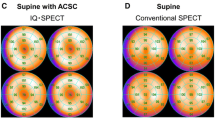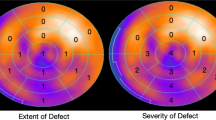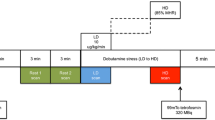Abstract
Background
ECG-gated SPECT myocardial perfusion imaging is usually acquired in supine position. However, some patients are not comfortable in this position for a variety of personal or medical reasons. Our aim was to investigate the effect of patient positioning on quantitative SPECT imaging results using normal supine database.
Methods
55 patients (mean age 58.5 ± 8.3 years) were enrolled in this prospective study. Each patient had a pair of ECG-gated stress SPECT myocardial perfusion images acquired on two gamma cameras: one in supine position and the other in upright sitting position. Left ventricular (LV) ejection fraction (EF), end-diastolic (ED), and end-systolic (ES) left ventricular volumes (V), LV mass, summed stress perfusion defect score (SSS), and total severity score (TSS) were calculated automatically relative to a supine normal reference database.
Results
There were no significant differences in LVEF using the two cameras (0.65 ± 0.08 vs. 0.66 ± 0.10; P > 0.1). However, EDV, ESV, and LV mass were significantly smaller in sitting position than in supine position (89 vs. 80 ml; 33 vs. 29 ml and 115 vs. 109 ml, respectively, all P < 0.0001). On the other hand, SSS and TSS were significantly higher in sitting position than in supine position (5.16 vs. 8.73 and 166.82 vs. 288.27, both P < 0.0001). Overall, more studies in sitting position were interpreted as abnormal than in supine position (P < 0.05).
Conclusion
Patient positioning has a significant impact on quantitative gated SPECT imaging results. Using a supine normal reference database, SSS and TSS were larger in sitting position than in supine position. Thus, for imaging in sitting position, separate normal limits are required.





Similar content being viewed by others
Abbreviations
- MPI:
-
Myocardial perfusion imaging
- SPECT:
-
Single photon emission computed tomography
- SSS:
-
Summed stress score
- TSS:
-
Total severity score
- LVEF:
-
Left ventricular ejection fraction
- EDV:
-
End-diastolic volume
- ESV:
-
End-systolic volume
- ECTb:
-
Emory cardiac tool box
- BMI:
-
Body mass index
References
Iskander S, Iskandrian AE. Risk assessment using single-photon emission computed tomographic technetium-99 m sestamibi imaging. J Am Coll Cardiol 1998;32:57-62.
Hachamovitch R, Hayes S, Friedman JD, Cohen I, Shaw LJ, Germano G, et al. Determinants of risk and its temporal variation in patients with normal stress myocardial perfusion scans: What is the warranty period of a normal scan? J Am Coll Cardiol 2003;41:1329-40.
Sharir T, Germano G, Kavanagh PB, Lai S, Cohen I, Lewin HC, et al. Incremental prognostic value of post-stress left ventricular ejection fraction and volume by gated myocardial perfusion single photon emission computed tomography. Circulation 1999;100:1035-42.
Shaw LJ, Iskandrian AE. Prognostic value of gated myocardial perfusion SPECT. J Nucl Cardiol 2004;11(2):171-85.
Iskandrian AE, Heo J, Mehta D, Tauxe EL, Yester M, Hall MB, et al. Gated SPECT perfusion imaging for the simultaneous assessment of myocardial perfusion and ventricular function in the BARI 2D trial: An initial report from the nuclear core laboratory. J Nucl Cardiol 2006;13(1):83-90.
Songy B, Lussato D, Guernou M, Queneau M, Geronazzo R. Comparison of myocardial perfusion imaging using thallium-201 between a new cadmium-zinc-telluride cardiac camera and a conventional SPECT camera. Clin Nucl Med 2011;36(9):776-80.
Garcia EV, Faber TL, Esteves FP. Cardiac dedicated ultrafast SPECT cameras: New designs and clinical implications. J Nucl Med 2011;52(2):210-7.
Ben-Haim S, Almukhailed O, Neill J, Slomka P, Allie R, Shiti D, Berman DS, Bomanji J. Clinical value of supine and upright myocardial perfusion imaging in obese patients using the D-SPECT camera. J Nucl Cardiol 2014;21(3):478-85.
Chawla D, Rahaby M, Amin AP, Vashistha R, Alyousef T, Martinez HX, Doukky R. Soft tissue attenuation patterns in stress myocardial perfusion SPECT images: A comparison between supine and upright acquisition systems. J Nucl Cardiol 2011;18(2):281-90.
Tonge CM, Armstrong IS, Arumugam P, James JM, Al-Bahrani GI, Lawson RS, et al. Changes in the appearance of attenuation artefacts due to change in posture in myocardial perfusion imaging. Nucl Med Commun 2008;29(5):441-7.
Tout D, Tonge C, Austin P, Adams J, Arumugam P. A comparison between upright and supine myocardial perfusion imaging with attenuation correction. Nucl Med Commun 2014;35(8):832-8.
Danias PG, Ahlberg AW, Travin MI, Mahr NC, Abreu JE, Marini D, et al. Visual assessment of left ventricular perfusion and function with electrocardiography-gated SPECT has high intraobserver and interobserver reproducibility among experienced nuclear cardiologists and cardiology trainees. J Nucl Cardiol 2002;9(3):263-70.
Nishina H, Slomka PJ, Abidov A, Yoda S, Akincioglu C, Kang X, et al. Combined supine and prone quantitative myocardial perfusion SPECT: Method development and clinical validation in patients with no known coronary artery disease. J Nucl Med 2006;47(1):51-8.
Nakazato Ryo, Tamarappoo Balaji K, Kang Xingping, Wolak Arik, Kite Faith, Hayes Sean W, et al. Quantitative upright-supine high-speed SPECT myocardial perfusion imaging for detection of coronary artery disease: Correlation with invasive coronary angiography. J Nucl Med 2010;51(11):1724-31.
Heo J, Htay T, Mehta D, Sun L, Lacy J, Iskandrian AE. Assessment of left ventricular function during upright treadmill exercise with tantalum 178 and multiwire gamma camera. J Nucl Cardiol 2005;12(5):560-6.
Ather S, Iqbal F, Gulotta J, Aljaroudi W, Heo J, Iskandrian AE, Hage FG. Comparison of three commercially available softwares for measuring left ventricular perfusion and function by gated SPECT myocardial perfusion imaging. J Nucl Cardiol 2014;21(4):673-81.
Rowland T, Unnithan V, Barker P, Guerra M, Roche D, Lindley M. Orthostatic effects on echocardiographic measures of ventricular function. Echocardiography 2012;29(5):523-7.
Schaefer WM, Lipke CS, Kühl HP, Koch KC, Kaiser HJ, Reinartz P, et al. Prone versus supine patient positioning during gated 99mTc-sestamibi SPECT: Effect on left ventricular volumes, ejection fraction, and heart rate. J Nucl Med 2004;45(12):2016-20.
Thadani U, West RO, Mathew TM, Parker JO. Hemodynamics at rest and during supine and sitting bicycle exercise in patients with coronary artery disease. Am J Cardiol 1977;39:776.
Thadani U, Parker JO. Hemodynamics at rest and during supine and sitting bicycle exercise in normal subjects. Am J Cardiol 1978;41:52.
Manyari DE, Kostuk WJ. Left and right ventricular function at rest and during bicycle exercise in the supine and sitting positions in normal subjects and patients with coronary artery disease. Assessment by radionuclide ventriculography. Am J Cardiol 1983;51(1):36-42.
Mahmarian JJ, Moye LA, Verani MS, Bloom MF, Pratt CM. High reproducibility of myocardial perfusion defects in patients undergoing serial exercise thallium-201 tomography. Am J Cardiol 1995;75:1116-9.
Berman DS, Kang X, Gransar H, Gerlach J, Friedman JD, Hayes SW, et al. Quantitative assessment of myocardial perfusion abnormality on SPECT myocardial perfusion imaging is more reproducible than expert visual analysis. J Nucl Cardiol 2009;16(1):45-53.
Paul AK, Hasegawa S, Yoshioka J, Tsujimura E, Yamaguchi H, Tokita N, et al. Characteristics of regional myocardial stunning after exercise in gated myocardial SPECT. J Nucl Cardiol 2002;9:388-94.
Ward RP, Gundeck EL, Lang RM, Spencer KT, Williams KA. Overestimation of postischemic myocardial stunning on gated SPECT imaging: Correlation with echocardiography. J Nucl Cardiol 2006;13(4):514-20.
Demir H, Kahraman G, Isgoren S, Tan YZ, Kilic T, Berk F. Evaluation of post-stress left ventricular dysfunction and its relationship with perfusion abnormalities using gated SPECT in patients with cardiac syndrome. Nucl Med Commun 2008;29(3):208-14.
Acknowledgments
This article was finalized under the auspices of the “Mentorship at Distance” committee of the Journal of Nuclear Cardiology. The authors gratefully acknowledge the editorial suggestions by Frans J. Th. Wackers, MD, PhD.
Disclosure
The authors have no conflict of interest.
Author information
Authors and Affiliations
Corresponding author
Rights and permissions
About this article
Cite this article
Kracskó, B., Barna, S., Sántha, O. et al. Effect of patient positioning on the evaluation of myocardial perfusion SPECT. J. Nucl. Cardiol. 25, 1645–1654 (2018). https://doi.org/10.1007/s12350-017-0865-4
Received:
Accepted:
Published:
Issue Date:
DOI: https://doi.org/10.1007/s12350-017-0865-4




